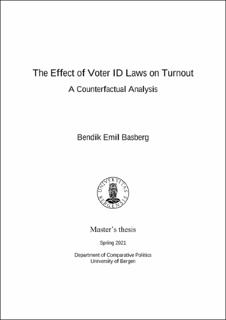| dc.description.abstract | In the United States, laws requiring voters to show ID in order to vote are both a novel and highly controversial policy intervention. Disagreement over these laws largely centers on their expected effect on turnout, with opponents arguing that ID-requirements will deter voters and proponents arguing that they will not. However, there is reason to suspect that these laws are in part adopted strategically to gain electoral advantage through lower turnout among supporters of the opposing party – in turn, backlash against voter ID similarly represents the opposing party safeguarding their electoral interests. If so, voter ID-laws are unanimously expected to lower turnout. These expectations are supported by rational choice theory, in that ID-requirements represent an increase in the costs of voting and, accordingly, should make those lacking valid ID less likely to vote. Research in the field has proven inconclusive, though many studies find at least partial evidence of a negative effect. The public and academic disagreement on the issue presents an opportunity and a need for a more stringent causal research design. Leveraging data on state-level turnout in US presidential elections between 1980 and 2020, I employ a synthetic control approach, using the matrix completion method to estimate turnout rates in voter ID-states over time in the counterfactual scenario in which they did not implement ID-requirements. Comparing actual turnout to this counterfactual turnout allows assessment of the causal impact of the intervention. Additionally, I investigate whether racial and ethnic minorities are affected more strongly than non-minority voters, using a difference-in-differences analysis of individual-level survey data. The analysis does not indicate that turnout rates in states with strict photographic ID-laws deviated significantly from what they otherwise would have been, neither overall nor among the demographic groups considered. The overall average treatment effect on the treated is estimated to lie between -2.86 and 5.03 percentage points change in turnout, though there is variation among individual states. Although the possibility of a small effect of voter ID-requirements on turnout cannot be ruled out, this study finds no significant evidence that one exists. | |
